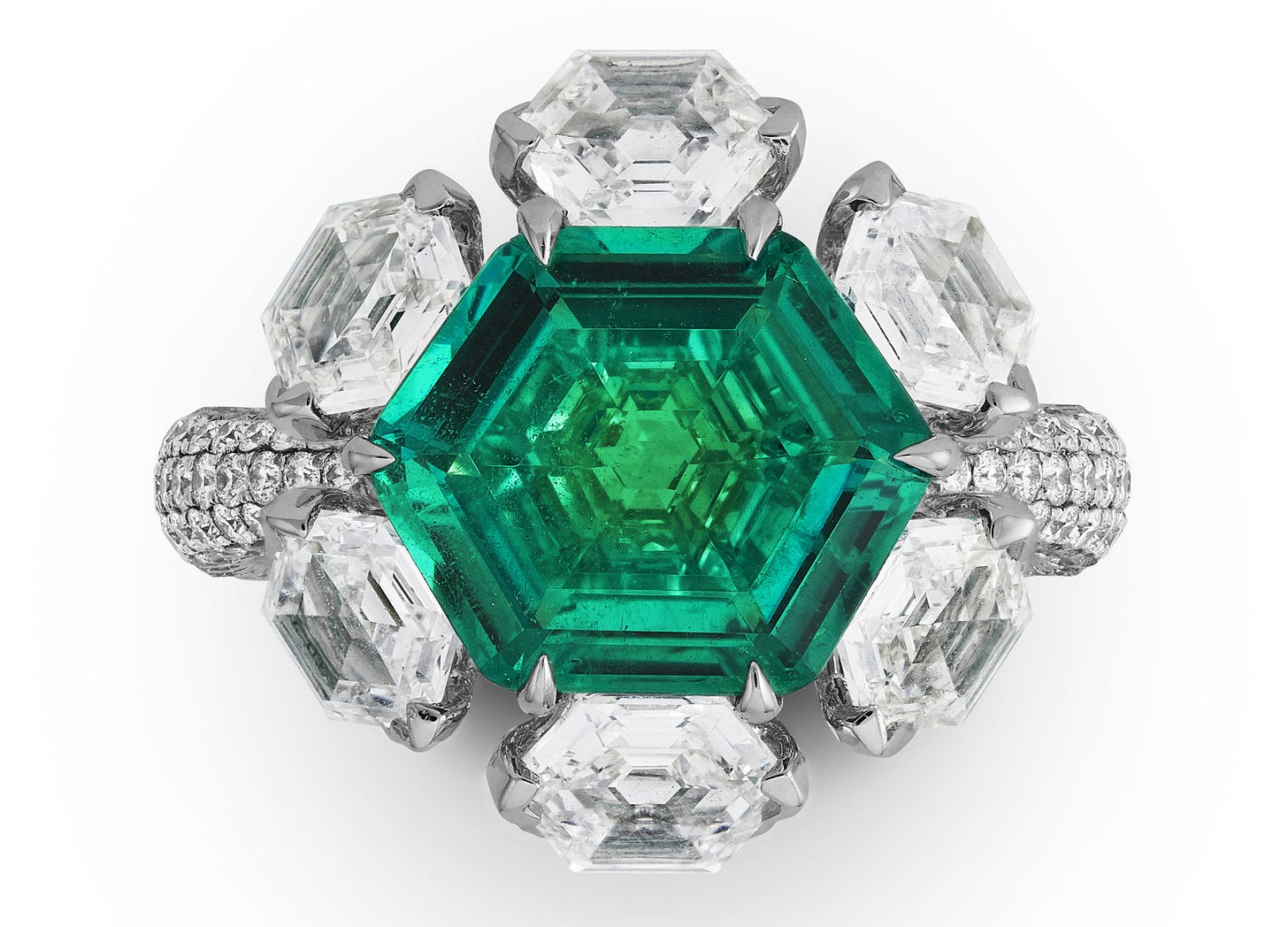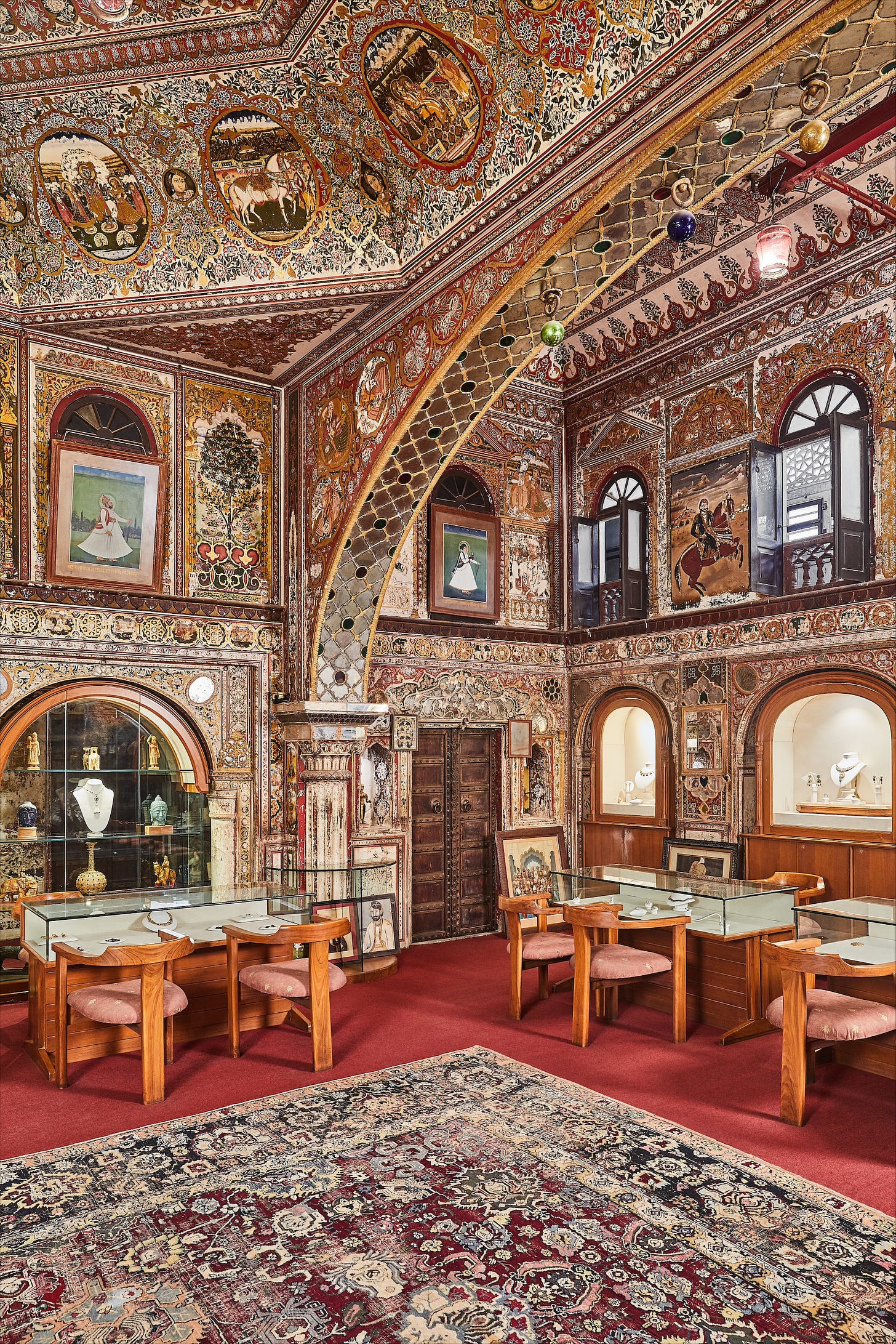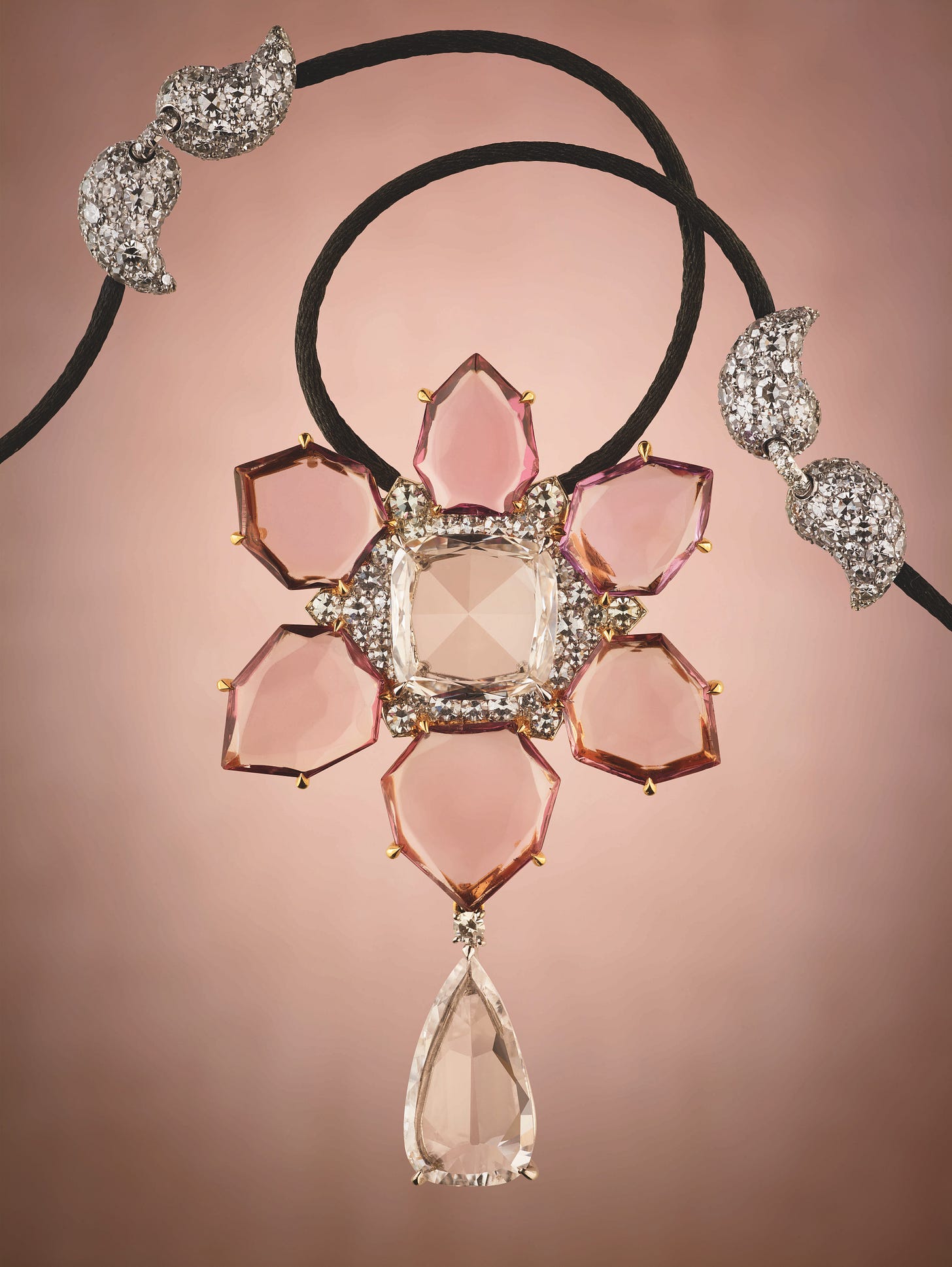A Splash Of Colour At TEFAF - 3 - SANTI
Krishna Choudhary discusses some extraordinary greens and pinks via pieces in his collection on view at TEFAF

So, after my ‘deep dive’ conversation with Kate Malone MBE in A Splash of Colour At TEFAF - 2 my intention was to make this particular post a bit more zippy - via ‘shallower dives’ into different objects from a range of periods and styles. But then I became so entranced by the mesmerising colours on view at SANTI, and so intrigued by the fascinating information the Choudhary family was willing to share with me that… oh well! This happened!
SANTI - TEFAF Stand 143
At TEFAF, much like you can do in other disciplines - like porcelain, or ancient artifacts, or modern paintings - you get to see jewellery companies who are at the top of their game on an international level. Whether it’s contemporary jewellers like TEFAF mainstays Otto Jakob and Hemmerle, or antique jewellery dealers like A La Vieille Russie, Wartski, and SJ Phillips, all these companies are showing extraordinary pieces that invite numerous superlatives.
And then on occasion a new jeweller appears who blows your mind in totally unexpected ways. This year (for me), that jewellery company is SANTI.
Although based in London’s Mayfair, the company’s roots are in Jaipur, India. And… can we talk about deep roots here?! For the last eleven generations, SANTI’s founder Krishna Choudhary’s family have sourced jewels and supplied exquisite gems to a diverse range of emperors, maharajahs and noble families. Much of this activity has happened from the family’s haveli - a richly decorated traditional mansion - dating to the 1700s and filled with frescoes and museum-quality artifacts.

Krishna founded SANTI in 2019, inspired by various things including his family’s long-standing history in the jewellery world, his own fascination with the depth of colours available in antique gemstones, and his respect for the long history of exceptional gem-cutting practices in India. India has been the biggest market for coloured gemstones for hundreds of years already, and still to this day, three quarters of the world’s emeralds are cut by lapidaries not just in India, but specifically in Jaipur.
Krishna’s charming and elegant wife, and his father, are also present in the stand. Mr Sharwan Choudhary is a delightful gentleman with a quick, mischievous laugh, and son and father appear to enjoy a close and supportive relationship. Mr Sharwan is the founder of Royal Gems & Arts, one of India’s most reputable and exclusive jewellery houses, based in Jaipur.
When I enquire about the derivation of the company’s name, SANTI, I hear a delightful story. Apparently Sharwan spent many of his teenage years in Italy, but none of his Italian friends could pronounce his Indian name correctly, so his nickname became, “Santi.” So, Krishna chose this name for their company, both to honour his father and to speak to the connections interlinking his family and many places in Europe, back and forth, over multiple centuries.
My conversation with Krishna that follows, has been edited for length and clarity.
Matthew: So, Krishna, as you know I’m doing this series about colour at TEFAF, and I’d like to begin our conversation with the subject of emeralds, and the very particular colour ‘emerald green’, which is of course, named after these stones. My understanding is that you only use antique Colombian stones, that have not been enhanced in any way, in your jewels, yes?
Krishna: Yes.
Matthew: So, what makes these stones so special? I have some ideas myself because I'm looking at an extraordinary one right now, right here in your booth, but my listeners and readers only have the wonderful photos you’ve shared with me to refer to. And if I may frame this question with the following… my husband tried to teach me, for a long time, how to spot what is known as a ‘pigeon's blood ruby’. I would suggest a stone I’d seen and he'd go, “No, no, too pink, or too orange, or too bright red.” And then when one day I finally saw one I just ‘got it’ in some deep part of myself. “Oh, so that’s the colour you mean!”
So, what are some factors that tell you you’re looking at an exceptional quality emerald?
Krishna: Well, let me start by saying these emeralds were the favourite stones for the Mughals*, and they always wanted to really use them in every piece they could commission, because these stones reminded them of the green of paradise.
* (The Mughal period in India, particularly famous for its jewellery and decorative arts, ran from 1526-1857.)
Matthew: Paradise green in terms of a spiritual paradise?
Krishna: Yes, a spiritual paradise, which is lush green, which is very happy, which is a very deep kind of forest green. And that's what I find in these emeralds, when they have, you might say, the entire package of everything: incredible colour, incredible light, and incredible saturation of this beautiful green colour. Deep green colour. And the beauty of the old mine emeralds is that, in a sense they flare their colour because of the strong materials they contain. And that's what makes them really, really special, I think, as opposed to what's being cut right now. They've survived so many years. They were the first ones to arrive at the Earth's crust.
So, when a stone has been formed over billions of years, the already best formed stones were mined earlier, hundreds of years ago. But the stones we're digging right now are still forming. There's a huge difference between an old mine and a new mine. It's similar for diamonds, emeralds, rubies, or any other stones. That's why when you see these beautiful emeralds, they have almost every quality imaginable because they've been formed beautifully over a very long time. What we're digging today, by comparison, is still kindof ‘raw’. So, no matter how much you cut or polish newer stones, they don't have the same fire. They don't have the same saturation of colour.
Matthew: So, are you saying that the newer stones are coming from deeper in the ground?
Krishna: Yes, and they are still forming. Which could take another, I don't know, a billion years perhaps.
Matthew: Oh, I finally get what you're saying! So, you mean the older ones have been sortof pushed upwards to the upper layers of the Earth’s crust, and the ones that are now found deeper down haven’t had that important benefit of time. It takes millions, in fact billions of years for the Earth’s forces of heat and pressure and chemical interactions to create the most intense combinations of hues and saturations of colours. Sorry for being a bit slow, but now I get it!

Matthew: So, in addition to these Colombian emeralds being billions of years old, how old would you say they are in terms of your family? Are they hundreds of years old?
Krishna: Yes indeed, some of them are hundreds of years old.
Matthew: Collected by previous generations of your family?
Krishna: Generations, yes. Or inherited. Or they've been moving across within families who are inheriting many historical stones. My family also developed the taste and colour palette to want to collect these stones from other families. So we always seek these kinds of stones – if one comes available, you try and grab it.
Matthew: Now… if I could just also ask you… you said that emeralds have this spiritual colour association. Do the blues of sapphires and the reds of rubies have similar spiritual connotations, or significance, in Indian life, would you say?
Krishna: I mean, emeralds, particularly, came in to light because of the Mughals, and these stones were coming from Colombia, in abundance. The Mughals also had access to many rubies and sapphires, but rubies were limited in their sizes. And sapphires were mostly used by one single Emperor, more so than the others. Mughal Emperor Jahangir loved using sapphires, but you don't really see other examples. Because this is also disputed in the Hindu culture. Every stone has a different energy to it and is related to every single planet. And an Indian astrologer would recommend wearing a certain stone to suit your personality. I think emeralds were probably the safest ones to wear easily, to then give away to family, and pass on down through generations.
(Krishna and I then move on to discuss pink…)
Krishna: So, spinels were coming from the back gardens of the Mughal Empire. And the Mughals were fascinated by this colour because they had access to all large stones – like diamonds, sapphires and emeralds; they could get all of these, but as I mentioned before, rubies didn't come in such very large sizes. And that's when they found spinels. Which were coming from Afghanistan, and that's when the Mughals started cherishing spinels. And the beauty about this pendant is that these are very flat-cut, late 18th to early 19th century spinels that have uniform colour. And the beautiful colour of these spinels, which are specific to this region, is this rose petal, pinkish colour, which in India we call laladi colour. And the beauty about them is that, even if you cut them very flat, they still retain all their colour. So this whole piece is also a testament to the artistry of Indian flat cutting techniques.

During one of my several visits to the Santi booth in the following days, to show yet another group of friends the wondrous creations on view, Mr Sharwan is kind enough to take an articulated titanium, gold, spinel and diamond bracelet out of a vitrine, and drape it over my friend Koos’s hairy wrist. Featuring ten 19th century Tajikistan spinels and numerous diamonds of various cuts and sizes, it’s an extraordinary piece of work that the Choudharys explain took three entire years to create.
But when Krishna points out to me that the sides of each frame are set with small, inverted diamonds that are so perfectly set they interlock between each other when the bracelet flexes, I become completely speechless.
Once I recover I say to Krishna, “You’re utterly crazy! Which I mean as a huge compliment - you’re crazy in the best, most wildly creative interpretation of crazy possible!” And with a wink and a nod to both of them I add, “And I suspect a lot of that comes from your father, non?!”
We all share laughter and hand shakes, and wish each other well. What unfogettable visits I’ve had with the Choudharys during TEFAF 2025!

Three final points:
• If you’re curious to learn more about the Mughal Empire, you’ll find an enormous amount of history, information and images in an article entitled The Arts of the Mughal Empire at the website of London’s V&A Museum. This article is presented as part of The Great Mughals: Art, Architecture and Opulence - a V&A South Kensington exhibition on view until Monday, 5 May 2025. This exhibition features a number of pieces on loan from the Choudhary family’s collection of important pieces of Mughal decorative arts.
• Krishna spoke of the crucial combination of “incredible colour, incredible light, and incredible saturation” to achieve an ideal stone. If you’re curious to know more about these scientific breakdowns of how colours are actually assembled through components of ‘hue, lightness and saturation’, please visit my article A Splash Of Colour (In Your Day) - Part Two.
• And if you’re simply curious to know more about the colour green, you might enjoy Green: The History of a Color. This is a book my Michael Pastoureau, who has a series called The History of a Color, where separate volumes also cover Blue, White, Pink, Yellow, Red, and Black. I have not yet read this series, but it was recommended to me by my friend Narayan Khandekar, who heads up the Forbes Pigment Collection at Harvard Art Museums - a collection that is well worth checking out if you’d like to delve further into the subject of colour.
(Narayan also recommended Blue: The Science and Secrets of the World’s Rarest Colour, that I referenced in Part One of this TEFAF series. That book I have read and it’s great!)
Thank you so much for reading or listening to this third edition of A Splash Of Colour At TEFAF. Next up, an intriguing exploration of both black and silver as colours with the wonderful, Wales-based Japanese artist and metalworker Junko Mori.
Until then, love and light,
Matthew.





